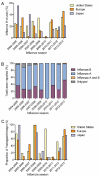Neuraminidase inhibitors for influenza B virus infection: efficacy and resistance
- PMID: 24013000
- PMCID: PMC3850058
- DOI: 10.1016/j.antiviral.2013.08.023
Neuraminidase inhibitors for influenza B virus infection: efficacy and resistance
Abstract
Many aspects of the biology and epidemiology of influenza B viruses are far less studied than for influenza A viruses, and one of these aspects is efficacy and resistance to the clinically available antiviral drugs, the neuraminidase (NA) inhibitors (NAIs). Acute respiratory infections are one of the leading causes of death in children and adults, and influenza is among the few respiratory infections that can be prevented and treated by vaccination and antiviral treatment. Recent data has suggested that influenza B virus infections are of specific concern to pediatric patients because of the increased risk of severe disease. Treatment of influenza B is a challenging task for the following reasons: This review presents current knowledge of the efficacy of NAIs for influenza B virus and antiviral resistance in clinical, surveillance, and experimental studies.
Keywords: Antiviral drug resistance; Influenza B virus; Neuraminidase inhibitors; Oseltamivir; Peramivir; Zanamivir.
Copyright © 2013 Elsevier B.V. All rights reserved.
Figures


Similar articles
-
Neuraminidase inhibitor susceptibility surveillance of influenza viruses circulating worldwide during the 2011 Southern Hemisphere season.Influenza Other Respir Viruses. 2013 Sep;7(5):645-58. doi: 10.1111/irv.12113. Epub 2013 Apr 10. Influenza Other Respir Viruses. 2013. PMID: 23575174 Free PMC article.
-
Global update on the susceptibility of human influenza viruses to neuraminidase inhibitors, 2015-2016.Antiviral Res. 2017 Oct;146:12-20. doi: 10.1016/j.antiviral.2017.08.004. Epub 2017 Aug 10. Antiviral Res. 2017. PMID: 28802866 Free PMC article.
-
Neuraminidase inhibitor susceptibility profile of pandemic and seasonal influenza viruses during the 2009-2010 and 2010-2011 influenza seasons in Japan.Antiviral Res. 2013 Sep;99(3):261-9. doi: 10.1016/j.antiviral.2013.06.003. Epub 2013 Jun 17. Antiviral Res. 2013. PMID: 23791870
-
Influenza virus resistance to neuraminidase inhibitors.Antiviral Res. 2013 May;98(2):174-85. doi: 10.1016/j.antiviral.2013.03.014. Epub 2013 Mar 22. Antiviral Res. 2013. PMID: 23523943 Review.
-
Neuraminidase inhibitor resistance in influenza viruses.J Med Virol. 2007 Oct;79(10):1577-86. doi: 10.1002/jmv.20951. J Med Virol. 2007. PMID: 17705169 Review.
Cited by
-
Sialidase Activity in Human Blood Serum Has a Distinct Seasonal Pattern: A Pilot Study.Biology (Basel). 2020 Jul 22;9(8):184. doi: 10.3390/biology9080184. Biology (Basel). 2020. PMID: 32708035 Free PMC article.
-
Lianhua-Qingwen Displays Antiviral and Anti-Inflammatory Activity and Synergistic Effects with Oseltamivir against Influenza B Virus Infection in the Mouse Model.Evid Based Complement Alternat Med. 2020 Jun 5;2020:3196375. doi: 10.1155/2020/3196375. eCollection 2020. Evid Based Complement Alternat Med. 2020. PMID: 32565852 Free PMC article.
-
Characterization of Influenza B Virus Variants with Reduced Neuraminidase Inhibitor Susceptibility.Antimicrob Agents Chemother. 2018 Oct 24;62(11):e01081-18. doi: 10.1128/AAC.01081-18. Print 2018 Nov. Antimicrob Agents Chemother. 2018. PMID: 30201817 Free PMC article.
-
Recent progress in chemical approaches for the development of novel neuraminidase inhibitors.RSC Adv. 2021 Jan 6;11(3):1804-1840. doi: 10.1039/d0ra07283d. eCollection 2021 Jan 4. RSC Adv. 2021. PMID: 35424082 Free PMC article. Review.
-
Human Antibodies Targeting Influenza B Virus Neuraminidase Active Site Are Broadly Protective.Immunity. 2020 Oct 13;53(4):852-863.e7. doi: 10.1016/j.immuni.2020.08.015. Epub 2020 Sep 24. Immunity. 2020. PMID: 32976769 Free PMC article.
References
-
- Aoki FY, Boivin G, Roberts N. Influenza virus susceptibility and resistance to oseltamivir. Antivir Ther. 2007;12:603–616. - PubMed
-
- Babu YS, Chand P, Bantia S, Kotian P, Dehghani A, El-Kattan Y, Lin TH, Hutchison TL, Elliott AJ, Parker CD, Ananth SL, Horn LL, Laver GW, Montgomery JA. BCX-1812 (RWJ-270201): discovery of a novel, highly potent, orally active, and selective influenza neuraminidase inhibitor through structure-based drug design. J. Med. Chem. 2000;43:3482–3486. - PubMed
-
- Bantia S, Arnold CS, Parker CD, Upshaw R, Chand P. Anti-influenza virus activity of peramivir in mice with single intramuscular injection. Antiviral Res. 2006;69:39–45. - PubMed
Publication types
MeSH terms
Substances
Grants and funding
LinkOut - more resources
Full Text Sources
Other Literature Sources

